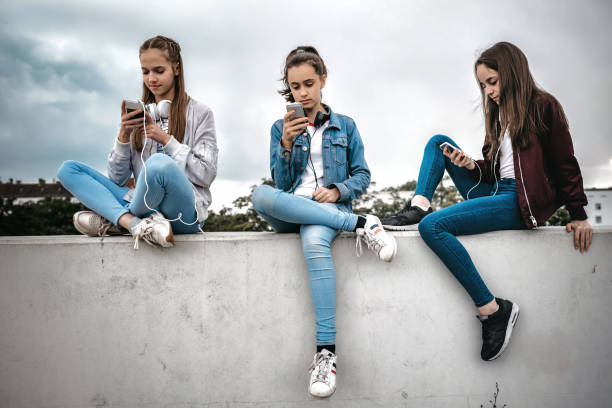Understanding the World of Social Media Girls

Social media girls are everywhere these days — they post, share, influence, compare, celebrate, and sometimes suffer. But who are they, really? This section digs into what “social media girls” means when you peel back the layers: the identities, the pressures, and the choices.
For many girls, social media is not just an app; it’s a stage, a mirror, a school, a gallery. They curate how they look, how they seem, how other people perceive them. At the same time, this world shapes their ideas of beauty, friendship, success, and worth. The term “social media girls” often refers to young women who are especially active on platforms like Instagram, TikTok, Snapchat, YouTube, or similar services — posting selfies, following trends, engaging in challenges, building followings, and often balancing real life with curated online personas.
But being a social media girl is complex. It involves navigating external expectations (beauty standards, follower counts, style), internal desires (to be seen, to belong, to be creative), and societal critique (the judgments from others, the comparisons that come, the mental health toll). Some embrace the power and potential of social media: using platforms for advocacy, self-expression, and community building. Others feel weighed down by the pressure: comparing themselves to filtered images, chasing likes, worrying what people think. Many do both: there is no single story, only many overlapping experiences.
Pressures That Social Media Girls Face
Social media girls carry unique burdens. This section unpacks what those pressures are, how they arise, and what their effects can be.
One major pressure is the beauty ideal pressure. Platforms are flooded with images of “perfect” bodies, flawless skin, ideal lighting, curated backgrounds, filters, and photo-editing. For girls who are growing, still figuring out who they are, who feel insecure about appearance or belonging, this can fuel self-criticism. Studies show adolescent girls often compare themselves unfavourably to peers or influencers, feeling that their bodies, faces, outfits, or lives don’t measure up.
Another pressure is the validation loop: getting likes, comments, followers becomes a way of measuring self-worth. A selfie that gets many likes can feel great; one that doesn’t can feel hurtful. The anticipation of feedback, the anxiety over whether a post will be “good enough,” the sense that what you share must always be interesting or attractive or trend-relevant — these weigh heavily. Social comparison is relentless.
Then there are internal conflicts: authenticity vs performance. Many girls want to share who they are, what they believe, and what they love. But social media sometimes seems to demand a performance: of beauty, of fun, of always being upbeat. That tension can lead to fatigue, stress, guilt, imposter-feeling, or feeling false. Also, online harassment or body shaming adds another layer: criticism, trolling, extreme comments, or just the subtle feeling that someone is always judging you.
Mental Health and Well-Being: The Hidden Costs
The pressures are not just emotional; they reach into mental health, self-esteem, and identity. This section examines the unseen tolls that social media girls often pay.
First, body dissatisfaction. Many girls report being unhappy with their bodies because of social media images and comparisons. In research, exposure to sexualized or idealised images is linked to increased body dissatisfaction among adolescent girls. Girls internalise appearance norms, sometimes believing their value depends on matching those norms.
Second, anxiety, depression, and stress. The constant comparison, fear of missing out (FOMO), need for approval, and sometimes cyberbullying can contribute to anxiety, low mood, and depression. Even when social media provides a connection, the emotional rollercoaster can undermine well-being.
Third, identity issues. Adolescence is a time of identity formation. When much of a girl’s self-image is built through the lens of what gets likes, what’s trending, and what’s accepted, there can be confusion about who she really is vs. who she feels she must present herself as. This can blur boundaries between genuine passions and what seems to draw attention online, which may lead to loss of authenticity. Also, girls with less power (in terms of race, class, body type, sexuality) may feel under‐represented or misrepresented, making it harder to find genuine role models.
The Positive Side: Opportunities & Growth
It’s not all negative. Social media offers avenues for empowerment, creativity, learning, and connection. This section explores how social media girls can and do use platforms for good.
Creativity and self-expression are powerful positive outcomes. Many girls use social media as a canvas: sharing artwork, fashion, music, opinions, and stories. This offers a chance to explore interests, find voice, refine craft. For some, that creativity becomes career-adjacent: influencers, content creators, activists. Social media lowers barriers: you don’t need traditional gatekeepers to share.
Community and connection are other benefits. Girls can find groups that share their experiences: body positivity, marginalised identities, activism, and mental health support. Sometimes being able to see others like you online, hearing their stories, feeling less alone — that can be deeply affirming. Organisations, peer networks, and support groups can grow from social media. For example, girls use platforms to campaign for social issues, environmental action, feminist causes, and access to education.
Also, learning and skill-building. Running a social media presence teaches editing, design, communication, marketing, and sometimes entrepreneurship. Girls who grow followings may learn negotiation, branding, and collaboration. Also, seeing diverse perspectives broadens horizons — exposure to cultures, ideas, activism, art, and science. If used wisely, social media can become a tool of awareness and growth.
Strategies & Coping for Social Media Girls
Knowing the risks and the positives, what can social media girls do to protect their well-being, keep authenticity, and still enjoy what social media has to offer? Here are expert-level strategies.
Digital literacy & critical thinking
- Don’t accept everything you see at face value. Filters, editing, staging, and “highlight reel” effect are real. Understanding that social media is often curated helps reduce the power of comparison.
- Learn about algorithms and how content is selected/shown: what you see often reinforces what you already like or engage with. Be aware that your feed is shaped by what you click, what you engage with.
Boundaries & time management
- Set limits for social media time. Maybe no social media first thing in the morning, or an hour before bed. Regular breaks help with mental rest.
- Manage notifications, mute or hide content that stresses you, unfollow accounts that consistently make you feel bad (even if they seem “aspirational”).
Self-care & authenticity
- Share what matters to you, not just what will get likes. Even small things: hobbies, your day, your thoughts. Authenticity often resonates more deeply.
- Practice being offline: hobbies, nature, reading, and face-to-face friendships. They ground your sense of self.
- Surround yourself with positive influences, both online and in real life. Find role models who are diverse, real, and honest.
Support & talking
- Talk to friends or mentors about how social media makes you feel. You may find others share the same struggles.
- Consider professional help if you feel anxiety, depression, or self-worth issues are severe or persistent.
Platform & content choices
- Curate your online environment. Follow body-positive, authenticity-promoting accounts. Engage with content that inspires or uplifts.
- Use privacy settings, consider what you share and with whom.
How Society & Platforms Can Help Social Media Girls
Girls’ experience on social media doesn’t depend only on personal strategies. There is a role for schools, parents, platforms, policy makers, and media. Here’s what can and should be done.
Education & awareness
Schools and educational programs should include digital well-being, how media shapes self-image, and mental health aspects of social media use. Starting young helps girls develop resilience before pressures deepen.
Platform accountability
Social media platforms need to better regulate harmful content (body shaming, bullying, unrealistic beauty ideals), promote diversity, and limit the reach of toxic trends. Algorithms should consider well-being, not only engagement.
Representation
Media and brands should show girls of different body types, skin tones, ages, and abilities. Representing realistic lives as well as aspirational ones helps more girls see themselves and feel less alienated.
Parental & adult support
Parents, guardians, and mentors should talk openly with girls about social media: its joys, its pitfalls. Rather than banning or shaming, help them develop critical perspectives and self-confidence.
Policy & regulation
Laws or policies could set standards for advertising transparency (when images are edited, when filters are used), protect children/adolescents from harmful content, require age verification, and encourage platform safety.
Stories: Voices of Social Media Girls
Putting faces on these issues helps us understand better. Here are some anonymised composite stories (drawn from studies and interviews) to illustrate what being a social media girl can look like in real life.
“Lena’s Story”
Lena is sixteen. She loves photography and posts her shots of nature, fashion, and friends on Instagram. But she also spends hours looking at influencer photos. She often edits her own photos, filters out what she doesn’t like. When she gets fewer likes than a peer, she feels small. She compares skin tone, body shape, and style. Sometimes she posts something personal and it does great; other times she posts something “safe” and still feels anxious. Lena wants to be true to herself, but fears being judged if she is not polished.
“Aisha’s Story”
Aisha is nineteen and from a small town. She uses TikTok to talk about issues she cares about: mental health, identity, and being queer. She gets both support and hate. Some followers love her authenticity; others criticise her voice, her appearance, her truth. She has to block or mute. But she feels empowered when someone says, “Thank you for speaking up.” She is learning to balance her platform with her own mental rest.
“Maja’s Story”
Maja is fourteen. She’s just started Snapchat and Instagram. She sees ads, beauty tutorials, and “perfect makeup face” videos. Her self-esteem is fragile. She wonders if she will ever look like those girls. Her school teaches about digital safety, but not much about how seeing filtered images shapes what she thinks a body or face “should” be. Maja trusts her mom, and they sometimes talk about what she sees online. It helps, but there are days when she feels invisible or “not enough.”
Quotes & Expert Voices
“Adolescent girls appear more vulnerable to experiencing mental health difficulties from social media use than boys.”
Girls tell me their lives feel like one long, endless performance, subject to critique on social media and off.
These voices remind us that the social media girls’ experience is intense, emotional, and often under-discussed.
FAQs (Frequently Asked Questions)
Here are some common questions about social media girls, answered clearly:
Q: Are social media girls more likely to suffer from mental health issues?
A: Not automatically, but they are at higher risk. Studies show that girls who frequently engage in appearance-focused content, or who compare themselves often on social media, tend to report more anxiety, depression, and body dissatisfaction. It also depends on other factors (support system, offline life, self-esteem, and ability to set boundaries).
Q: Is following influencers bad?
A: Not necessarily. Influencers can inspire, teach, and entertain. But problems arise when influencers promote unrealistic beauty standards, heavily edited images, and constant perfection. If a girl feels worse after following someone, that’s a signal: maybe unfollow, or limit how much time is spent engaging with that content.
Q: Can social media be completely avoided, or should it be used?
A: It’s rare and difficult to avoid completely, especially for teenage girls. But usage can be healthier: use with awareness, limit time, stay selective about content and interaction, and balance online with offline life. Many experts recommend not banning, but coaching healthy habits.
Q: How can parents and educators help social media girls?
A: By opening safe dialogues about self-image, what’s real vs curated, providing support when girls express insecurity. Also, by encouraging offline pursuits, role models, teaching digital literacy, and helping regulate exposure.
Q: Do platforms have responsibility?
A: Yes. Platforms can do more to reduce harmful content, limit or make clear filters & editing, regulate advertisements, protect from harassment, and prioritise user well-being over engagement metrics.
Conclusion
Social media girls are navigating a nuanced world — one full of creativity, community, and opportunity, but also full of pressures, comparisons, and risk. The performance of identity, the chase for validation, the impact of idealised appearances — these are real, lived experiences. But they are not unchangeable.
What can help fundamentally is awareness (from girls themselves, from parents, from schools, from platforms), authenticity, healthier boundaries, positive representation, and platforms and policies that protect well-being. If these pieces work together, social media can become a place not just of performance and comparison, but of empowerment, growth, and genuine connection.

